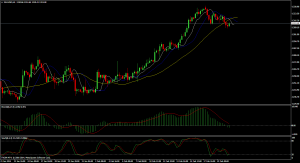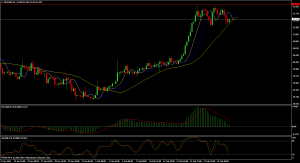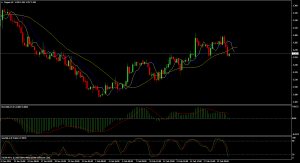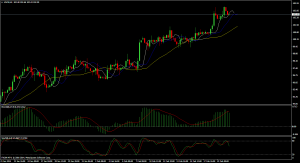Gold moved lower overnight to open at 1318.50/1319.50. It surged to a high of 1322.00/1323.00 following weak U.S. housing market data including a drop in housing starts to a three-year low. The metal then retreated to a low of 1317.25/1318.25 amidst selling pressure prior to release of minutes of the U.S. Fed’s January meeting, which also dragged Treasuries lower. It closed the day at 1320.00/1321.00.
 Gold
closed lower again today at 1320, but traded within yesterday’s range.
The consolidation has allowed RSI to fall from ‘overbought’ levels in
the 75-area, back to 68. We view this as a correction in the uptrend off
the December 31st low, with support at 1302, the 22-day moving average.
Resistance is at 1337, the 61.8% retracement of the August to December
2013 downtrend.
Gold
closed lower again today at 1320, but traded within yesterday’s range.
The consolidation has allowed RSI to fall from ‘overbought’ levels in
the 75-area, back to 68. We view this as a correction in the uptrend off
the December 31st low, with support at 1302, the 22-day moving average.
Resistance is at 1337, the 61.8% retracement of the August to December
2013 downtrend.Gold edged lower as the dollar steadied ahead of the Federal Reserve’s minutes of its January meeting
Tuesday’s New York manufacturing and U.S. housing data were the latest numbers out of the United States to disappoint investors.
SPDR gold trust holding dropped by 5.64 tonnes i.e. 0.70% to 795.61 tonnes from 801.25 tonnes.
SILVER
Silver edged marginally lower overnight to open at 21.82/21.87. It followed gold to a high of 21.90/21.95 before falling to a low of 21.74/21.79. It was mostly range bound closing the session at 21.83/21.88.
 Silver
closed lower today at 21.83, consolidating a move that took the metal
from 20.45 to 22.06 in the past four sessions. Support is at yesterday’s
low in the 21.32 area, with resistance at 23.09, the high from October
2013. Technicals continue to be bullish since silver’s breakout from its
sideways consolidation last week.
Silver
closed lower today at 21.83, consolidating a move that took the metal
from 20.45 to 22.06 in the past four sessions. Support is at yesterday’s
low in the 21.32 area, with resistance at 23.09, the high from October
2013. Technicals continue to be bullish since silver’s breakout from its
sideways consolidation last week. The gold-silver ratio is trading higher today at 60.58. The chart looks bearish since the ratio broke below its uptrend that had been in place since August 2013. The target is a full retracement to the 57.09 low.
Silver remained lower, but recovered some of losses following the release of disappointing data on U.S. housing starts and building permits.
Minutes of Fed’s Jan. policy meeting showed officials wanted to drive home the idea that their asset-purchase program would be trimmed in predictable
The U.S. Commerce Department said that number of building permits issued last month declined by 5.4% to a seasonally adjusted 937,000 units.
COPPER
On the Comex division of the New York Mercantile Exchange, copper futures for March delivery traded in a range between $3.281 a pound and $3.300 a pound.
Copper prices last traded at $3.290 a pound during European morning hours, up 0.15%. The March copper contract ended Tuesday’s session 0.64% higher to settle at $3.285 a pound.
 Futures
were likely to find support at $3.253 a pound, the low from February 18
and resistance at USD3.320 a pound, the high from February 18.
Futures
were likely to find support at $3.253 a pound, the low from February 18
and resistance at USD3.320 a pound, the high from February 18.Investors were looking ahead to the minutes of the Federal Reserve’s January meeting later in the trading day, when the bank voted to cut its stimulus program by another $10 billion to $65 billion per month.
Earlier this month Fed Chair Janet Yellen indicated that the central bank is on track to maintain the pace of reductions to its stimulus program, as long as the economy continues to improve as expected.
Later Wednesday, the country was to publish reports on building permits, housing starts and producer price inflation.
Data on Tuesday showed that the Empire State manufacturing index fell more-than-expected in February as new orders dropped.
A separate report showed foreign investors sold almost $120 billion of U.S. assets in December.
The disappointing data added to concerns that the U.S. economic recovery has lost momentum since the end of last year as inclement winter weather weighed on growth.
Copper futures fluctuated between small gains and losses on Wednesday, as market players eyed the minutes of the Federal Reserve’s latest policy meeting.
CRUDE
On the New York Mercantile Exchange, West Texas Intermediate crude for delivery in April traded at $102.77 a barrel during Asian trading, down 0.07%.
On Wednesday, the New York-traded oil futures hit a session low of $102.74 a barrel and a high of $103.00 a barrel. The April contract settled at $102.84 a barrel.
Nymex oil futures were likely to find support at $99.41 a barrel, Thursday’s low, and resistance at $102.95 a barrel, the high from Oct. 16.
 Strong
winter storms that swept over the northeastern U.S. on Tuesday and
brought strong winds and fresh snowfall likely hiked demand for heating
oil, investors were betting.
Strong
winter storms that swept over the northeastern U.S. on Tuesday and
brought strong winds and fresh snowfall likely hiked demand for heating
oil, investors were betting.Chilly forecasts sent oil prices climbing, as did unrest in crude-rich Venezuela and Libya.
The rally cooled somewhat as investors jumped to the sidelines to await the release of the Federal Reserve’s January policy meeting minutes later.
Insight on the U.S. central bank’s $65 billion bond-buying program could move prices by either strengthening or weakening the dollar.
Nymex crude prices fell slightly during Asian trading hours on Thursday after climbing to their 2014 high on Wednesday as the markets weighed weather concerns in the U.S. along with heating oil inventories.
Technical Levels
| SUPPORT 1 | SUPPORT 2 | RESISTANCE 1 | RESISTANCE 2 | |
| GOLD | 1312 | 1304 | 1325 | 1332 |
| SILVER | 21.49 | 21.14 | 22.08 | 22.31 |
| COPPER | 3.2720 | 3.2585 | 3.3005 | 3.3155 |
| CRUDE | 102.50 | 101.70 | 103.95 | 104.57 |
Commodity
Contract S2 S1 R1 R2
Global
Economic Data
| TIME :IST | DATA | PRV | EXP | IMPACT |
| 7.00P.M | Core CPI m/m | 0.1% | 0.1% | STRONG |
| 7.00P.M | Unemployment Claims | 339K | 335K | STRONG |
| 8.30P.M | Philly Fed Manufacturing Index | 9.4 | 9.2 | STRONG |
Core
CPI m/m
Source
|
Bureau of Labor Statistics (latest release) |
Measures
|
Change in the price of goods and services purchased by consumers, excluding food and energy; |
Usual
Effect
|
Actual > Forecast = Good for currency; |
Frequency
|
Released monthly, about 16 days after the month ends; |
Next
Release
|
Mar 18, 2014 |
FF
Notes
|
Food and energy prices account for about a quarter of CPI, but they tend to be very volatile and distort the underlying trend. The FOMC usually pays the most attention to the Core data - so do traders; |
Why
Traders
Care |
Consumer prices account for a majority of overall inflation. Inflation is important to currency valuation because rising prices lead the central bank to raise interest rates out of respect for their inflation containment mandate; |
Also
Called
|
CPI Ex Food and Energy, Underlying CPI; |
Acro
Expand
|
Consumer Price Index (CPI), Federal Open Market Committee (FOMC) |
Unemployment
Claims
Source
|
Department of Labor (latest release) |
Measures
|
The number of individuals who filed for unemployment insurance for the first time during the past week; |
Usual
Effect
|
Actual < Forecast = Good for currency; |
Frequency
|
Released weekly, 5 days after the week ends; |
Next
Release
|
Feb 27, 2014 |
FF
Notes
|
This is the nation's earliest economic data. The market impact fluctuates from week to week - there tends to be more focus on the release when traders need to diagnose recent developments, or when the reading is at extremes; |
Why
Traders
Care |
Although it's generally viewed as a lagging indicator, the number of unemployed people is an important signal of overall economic health because consumer spending is highly correlated with labor-market conditions. Unemployment is also a major consideration for those steering the country's monetary policy; |
Also
Called
|
Jobless Claims, Initial Claims; |
Philly
Fed Manufacturing Index
Source
|
Federal Reserve Bank of Philadelphia (latest release) |
Measures
|
Level of a diffusion index based on surveyed manufacturers in Philadelphia; |
Usual
Effect
|
Actual > Forecast = Good for currency; |
Frequency
|
Released monthly, around the middle of the current month; |
Next
Release
|
Mar 20, 2014 |
FF
Notes
|
Above 0.0 indicates improving conditions, below indicates worsening conditions; |
Why
Traders
Care |
It's a leading indicator of economic health - businesses react quickly to market conditions, and changes in their sentiment can be an early signal of future economic activity such as spending, hiring, and investment; |
Derived
Via
|
Survey of about 250 manufacturers in the Philadelphia Federal Reserve district which asks respondents to rate the relative level of general business conditions; |





Stock trading tips for Copper trading range for the day is 446.3-452.7.
ReplyDelete